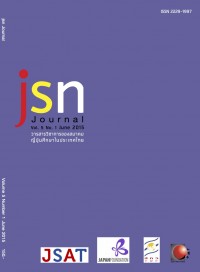บทบาทและหน้าที่ของดนตรีในเทศกาลอะซะกุสะคันนง
Main Article Content
Abstract
จากการศึกษาพบว่า ในเทศกาลอะซะ กุสะคันนงมีดนตรีเข้าไปเกี่ยวข้องเช่นเดียวกับ เทศกาลขบวนแห่และรถลากในพื้นที่อื่นๆ ทั้ง บทเพลงและดนตรีบรรเลงประกอบ เครื่องดนตรี ที่ใช้ประกอบด้วยกลอง (ไทโกะ) ขนาดต่างๆ ขลุ่ย (ทะเคะบุเอะ) และ ฆ้อง (อะตะริคะเนะ) อีกทั้งมีการผสมผสานกับวัฒนธรรมนาฏศิลป์ที่มี การร่ายรำและเต้นรำ ในรูปแบบต่างๆ ผู้ที่บรรเลง มีทั้งชายและหญิง ทั้งเยาวชนและผู้ใหญ่ การ บรรเลงมีทั้งบรรเลงดนตรีล้วนๆ ขับร้องล้วนๆ หรือ ผสมผสานกัน บทบาทหน้าที่ที่สำคัญของดนตรี ในเทศกาลอะซะกุสะคันนงที่สำคัญคือ นอกจากสร้างสีสันและเพิ่มความสนุกสนานเร้าใจแล้ว ยัง แฝงไว้ซึ่งการสร้างความสามัคคีของคนในชุมชน นั้นๆ ด้วยการที่ต้องใช้ความสามัคคีในการฝึก ซ้อมดนตรีร่วมกัน ทั้งยังช่วยสืบสานวัฒนธรรม ดนตรีประจำชาติจากคนรุ่นเก่าสู่คนรุ่นใหม่ด้วย ที่สำคัญการที่ชุมชนอะซะกุสะมีเทศกาลนี้เป็น ประจำทุกปี ยังมีส่วนช่วยให้ผู้คนในชุมชนที่ไป ทำงานต่างถิ่นได้กลับมาบ้านเกิดเพื่อพบปะพูด คุย และทำให้เยาวชนที่ไปอาศัยอยู่ต่างถิ่นได้ กลับมารู้จักกัน อันเป็นส่วนสำคัญในการสร้างความ เข้มแข็งกับชุมชนโดยมีดนตรีเป็นเครื่องมือ
วัฒนธรรมดนตรีในเทศกาลอะซะกุ สะ นับว่ามีบทบาทมากกว่าความบันเทิงและ การสร้างสีสันให้เทศกาล แต่ยังมีส่วนช่วยสร้าง ความเข้มแข็งและสืบสานวัฒนธรรมดนตรีของ ญี่ปุ่นให้คงอยู่อย่างต่อเนื่องอีกด้วย ซึ่งจะเห็น ได้ว่าแม้ประเทศญี่ปุ่นจะมีความก้าวหน้าทาง เทคโนโลยีค่อนข้างมาก แต่ในสังคมญี่ปุ่นเองก็ ไม่ละเลยที่จะให้ความสำคัญกับวัฒนธรรมที่เป็น อัตลักษณ์ประจำชาติที่สำคัญต่างๆ โดยมีการ ผสมผสานหลายส่วนทั้งประเพณีและศิลปะต่างๆ ดังเช่นวัฒนธรรมทางดนตรีที่ปรากฏในเทศกาล อะซะกุสะคันนงนี้
Role and Function of Music in Asakusa Kannon Festival
Noppadol Tippayarat*
In any Japanese festival, music is always involved. This is not only because music provides the attendees with a lot of joy and fun in the festival itself, but the music also plays important roles and duties in the community as well. The objective of this study was to investigate the characteristics of Asakusa music, as well as to study the roles and function of this kind of music in the community. Various methods were employed, including ethnomusicology, study of the pertinent literature, field data gathering, and interviewing people in the community.
The Asakusa Kannon Festival has music components just as in other regions, both in terms of lyrics and music. The musical instruments are comprised of Taiko (Drums of various sizes), Takebue (Flutes) and Atari-Kane (Gong). Other than music, Asakusa also has various types of dance which can be performed by males, females, children, older people, and so on. Other than providing joy and fun, another object of the Asakusa Kannon Festival is to create team building among the people in the community via performing as well as practicing this type of music. Moreover, the Asakusa Kannon Festival also provides an opportunity for the older generation to pass on the national tradition and culture to the younger generation. In addition, the Asakusa Kannon Festival helps to bring back those that work far away from the community to the community by joining the festival. This is perhaps the most important strength that the Asakusa Kannon Festival gives to the community.
The tradition and culture of the Asakusa Kannon Festival are far more important than just being an entertaining event; it also builds strength for the community and passes on the tradition from one generation to another. Even though Japan today has far more advancements in technology compared to many countries in the world, it has never ignored the importance of the tradition and culture of their own national identity in various types of arts and performances, as can be seen with the Asakusa Kannon Festival.
* Associate Prof. Dr., Faculty of Fine and Applied Arts, Prince of Songkla University, Pattani Campus, Address: 181 Moo 6, Tambon Rusamilae, Muang, Pattani 94000
Article Details
ข้อความและข้อคิดเห็นต่างๆ ในบทความเป็นของผู้เขียนบทความนั้นๆ ไม่ใช่ความเห็นของกองบรรณาธิการหรือของวารสาร jsn Journal


